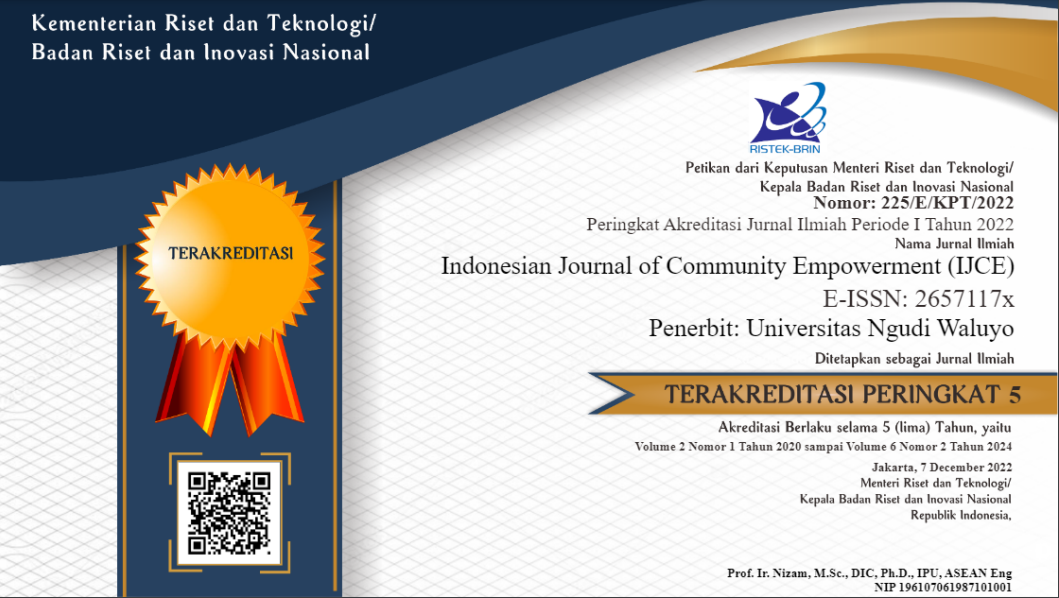Peningkatan Konsentrasi Belajar dengan Yoga Anak
DOI:
https://doi.org/10.35473/ijce.v5i1.2340Keywords:
Keywords: child yoga, preschooler, study concentration, Kata kunci: yoga anak, anak prasekolah, konsentrasi belajar.Abstract
Preschool-age children are children aged 3-6 years where in this period physical growth slows down and psychosocial and cognitive growth will increase. During this period, children can develop their curiosity and be able to speak well. Playing is a tool that children use to develop their social relations with other people in their surroundings, so that at this time it requires concentration in learning. Several studies explain that practicing yoga can help children become calmer and more focused, as well as improve children's ability to plan or concentrate on learning. This service is carried out in 3 stages, namely the first stage is the selection of targets for the application of children's yoga, namely at an early age, the second stage is the application of children's yoga, the third stage is the evaluation of activities by measuring the concentration of learning at an early age. Community service activities are going well and smoothly, there is an expansion of the results of community service with the results of previous research where the level of concentration in children's learning is good. It is hoped that activities like this can take place irrationally so that other preschoolers can feel them.
ABSTRAK
Anak usia prasekolah merupakan anak yang berumur 3-6 tahun dimana pada periode ini terjadi pertumbuhan fisik yang menjadi lambat dan pertumbuhan psikososial dan kognitif akan mengalami kenaikan. Periode ini anak dapat mengembangkan rasa ingin tahunya serta mampu berbicara dengan baik. Bermain merupakan alat yang digunakan anak untuk mengembangkan sosialnya terhadap orang lain di lingkungan sekitarnya, sehingga pada masa ini dibutuhkan konsentrasi dalam belajar. Beberapa studi menjelaskan bahwa latihan yoga dapat membantu anak menjadi lebih tenang dan lebih fokus, dan meningkatkan kemampuan anak dalam melakukan perencanaan atau berkonsentrasi dalam belajar. Pengabdian ini dilaksanakan dalam 3 tahap yaitu Tahap Pertama adalah pemilihan sasaran penerapan yoga anak yaitu pada anak usia dini, Tahap kedua adalah penerapan yoga anak, Tahap ketiga adalah evaluasi kegiatan dengan pengukuran konsetrasi belajar pada anak usia dini. Kegiatan pengabdian masyarakat berjalan dengan baik dan lancar, terdapat kesesuaian hasil pengabdian dengan hasil-hasil penelitian terdahulu dimana tingkat konsentrasi belajar pada anak menjadi baik. Diharapkan kegiatan seperti ini dapat berlangsung secara berkesinambungan agar manfaatnya bisa dirasakan oleh anak prasekolah lainnya.
References
Chaya, M. S., Nagendra, H., Selvam, S., Kurpad, A., & Srinivasan, K. (2012). Effect of Yoga on Cognitive Abilities In Schoolchildren from a Socioeconomically Disadvantaged Background: A Randomized Controlled Study. The Journal of Alternative and Complementary Medicine, 18(12), 1161–1167. https://doi.org/10.1089/acm.2011.0579
Cohen, S. C. L., Harvey, D. J., Shields, R. H., Shields, G. S., Rashedi, R. N., Tancredi, D. J., Angkustsiri, K., Hansen, R. L., & Schweitzer, J. B. (2018). Effects of Yoga on Attention, Impulsivity, and Hyperactivity in Preschool-Aged Children with Attention-Deficit Hyperactivity Disorder Symptoms. Journal of Developmental & Behavioral Pediatrics, 39(3), 200–209. https://doi.org/10.1097/DBP.0000000000000552
Gunarta, I. K. (2017). IMPLEMENTASI PEMBELAJARAN YOGA DALAM MENINGKATKAN KONSENTRASI BELAJAR DI SEKOLAH DASAR NEGERI 1 SUMERTA. Jurnal Penjaminan Mutu, 3(2), 180. https://doi.org/10.25078/jpm.v3i2.198
Nicki L. Potts, & Barbara L. Mandleco. (2012). ediatric Nursing; Caring for Children and Their Families. Cengage Learning.
Oberer, N., Gashaj, V., & Roebers, C. M. (2018). Executive functions, visual-motor coordination, physical fitness and academic achievement: Longitudinal relations in typically developing children. Human Movement Science, 58, 69–79. https://doi.org/10.1016/j.humov.2018.01.003
Slameto. (2010). Belajar dan faktor-faktor yang mempengaruhinya. Rineka Cipta.
Sofiyanti, I., Astuti, F. P., & Setyowati, H. (2020). Meningkatkan Kesehatan Fisik dan Kesehatan Mental Anak dengan Yoga di Masa Adaptasi Kebiasaan Baru. INDONESIAN JOURNAL OF COMMUNITY EMPOWERMENT (IJCE), 2(2). https://doi.org/10.35473/ijce.v2i2.765
Sofiyanti, I., & Setyowati, H. (2021). Satu Bulan Penerapan Yoga Anak Meningkatkan Konsentrasi Belajar Usia Prasekolah. Indonesian Journal of Midwifery (IJM), 4(2), 150. https://doi.org/10.35473/ijm.v4i2.1236
Sue C. DeLaune, & Patricia K. Ladner. (2011). Fundamentals of Nursing Standards & Practice (Fourth). Delmar Cengage Learning.
Susannah Hoffman. (2018). Yoga for Kids. DK Publishing.
Yohana E. Hardjadinata. (n.d.). Yoga for Kindergarten Yoga untuk Anak Taman Kanak-Kanak. Dian Rakyat.



